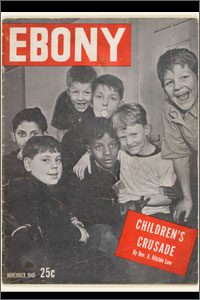On Nov. 1, 1945, America got its first look at Ebony, a monthly coffee-table magazine modeled after Look andLife but whose goals were to focus on the achievements of blacks from “Harlem to Hollywood� and to “offer positive images of blacks in a world of negative images.�
Founded by publisher John H. Johnson, Ebony’s first cover ironically did not feature a glamorous black entertainer or an African-American “first� but seven boys — six of them white — from a program to improve race relations. The first issue sold out at 25, 000 copies. Circulation peaked at nearly 2 million in 1997.
In addition to the fashion and beauty stories that continue to be Ebony mainstays, the magazine also tackled civil rights, education and black entrepreneurship, stories important to the black community that mainstream publications often ignored.
Through the lens of longtime Ebony photographer Moneta Sleet who died in 1996, Ebonywas at the forefront of some of the most important stories in history.
Sleet was there in 1955 when the Rev. Martin Luther King Jr. organized the Montgomery, Ala., bus boycott; in 1964 when King won the Nobel Peace Prize; and in 1965 when King led the march from Selma, Ala., to Montgomery.
On April 9, 1968, Sleet was at King’s funeral, five days after a sniper’s bullet felled the civil rights leader. When King’s widow, Coretta Scott King, discovered that the press pool covering her husband’s funeral included no black photographers, she sent word: If Sleet wasn’t allowed into the church, there would be no photographers, period.
Sleet’s photograph of Mrs. King tearfully clasping daughter Bernice appeared in Ebony’s May 1968 issue and won Sleet a Pulitzer Prize, making him the first African-American photographer to win the highest honor for news.
In 2008, Ebony featured another historic “first� by publishing the first post-election interview with the country’s first black president, Barack Obama.
Today, Ebony remains a standard for middle-class African Americans with a circulation in 2010 of 1.1 million.
An exhibit on John H. Johnson, Ebony and other minority publications is currently displayed in the News Corporation News History Gallery.
– newseum
